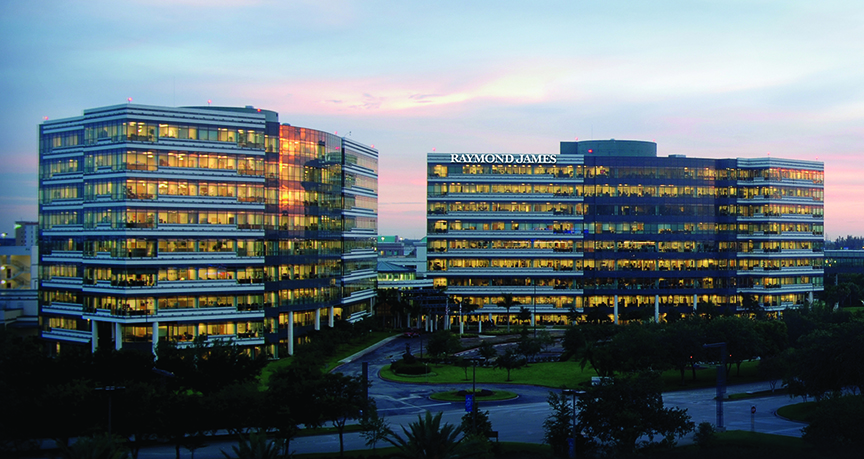Know
How Raymond James is adapting in the COVID-19 pandemic

Raymond James Financial made an “almost seamless” transition in the workplace amid the COVID-19 pandemic.
The St. Petersburg-based financial services firm went from 99 percent of its employees working in the office to 95 percent working from home in one week, said Paul Reilly, chairman and CEO, speaking during a recent investor conference.

Paul Reilly, chairman and CEO, Raymond James Financial
The workplace shift took place as Raymond James was experiencing record trading volume, Reilly said.
“The systems all held up. We were able to handle all the calls,” he said during Morgan Stanley’s Virtual U.S. Financials Conference June 10.
Reilly credited two factors — a culture of pitching in and helping out, as well as an investment in technology by Raymond James (NYSE: RJF), one of the largest companies based in the Tampa-St. Petersburg area, with $7.7 billion in revenue for fiscal year 2019. It’s St. Petersburg’s largest employer with about 4,700 workers in the city.
“We’ve learned that if 95 percent of people can work from home and productivity doesn’t fall, certainly we don’t need 99 percent of people in the office. The office and the meetings, from a cultural standpoint and a bonding standpoint and deep strategic discussions, are certainly helpful for any organization, but there’s no reason why people can’t work more often from home,” Reilly said
Ironically, just a week before Raymond James shut its office, the company had hired an executive who previously led mobility efforts at PwC.
“I told him he had five years to get us to where 30 percent of our people were working from home and everyone had mobile capability,” Reilly said. “After he was here a month, I said I really meant five weeks.”
Longer term, Reilly said, he believes more people will continue to work from home.
“We’ve learned we can have effective meetings like this, a conference without flying. We’ve learned that clients have learned these technologies where they were afraid of them before. We have 80-year-old clients on Zoom and doing e-signature, which didn’t happen before the pandemic very often,” Reilly said. “So I think it is going it is change how we work, but we’ll have to learn. I think part of that depends on the course of the virus. If we get into a heavy second wave, I think people are going to be more leery about going into the office. If we get a vaccine and it goes away, we’ll see what that new normal is. I don’t think it’s going to be 80 percent working from home, but I don’t think it’s going to be 80 or 90 percent wanting to come into the office every day.”
A decade ago, Raymond James spent about $100 million a year on technology. Now, the company’s annual technology budget is about $400 million.
Related: Here are seven technologies that Raymond James counts on for growth
That spending — much of it on technology that advisors use to help their clients — paid off during the pandemic in advisor productivity.
“I see $10 million and $20 million and $30 million accounts come over, and the advisors tell me they’ve never personally met with client. It was all over Zoom. It really shows the power to advisors of having clients anywhere,” Reilly said.
One growth strategy for Raymond James has been recruiting additional financial advisors. Fiscal year 2019 was the second-best recruiting year for the company and it was off to a better start in FY 2020 when the pandemic hit.
“When COVID hit, at first everything stopped. We’ve learned during COVID now that we could do things virtually in that regard too,” Reilly said.
The company normally does home office visits, where prospective advisors visit the headquarters in Carillon to learn about products, services, tools and company culture. Those visits also give Raymond James a chance to assess the candidates to make sure they are a good fit.
“Now, we’ve conducted about 50 of those visits virtually in the past month. It’s not the same but we’ve had people agree to join us virtually. We have more of a backlog, and the recruiting demand in the last few weeks, the number of calls, have skyrocketed,” Reilly said.
While it’s great to get new advisors, Reilly said, the company’s culture is focused on retaining its current advisors, who in turn are strong recruiters.
“Our first job is to focus on keeping who we have. The second, the way we help keep them, is providing them great technology … That’s what keeps them,” Reilly said.
Raymond James suspended stock buybacks in recent weeks, an action that CNBC reported was taken by many other publicly traded companies during the pandemic.
“The first couple of weeks, we were buying stock as it was going down when the crisis first hit. There were a couple of weeks there when the financial markets were very stressed,” Reilly said. “We suspended buybacks. And frankly buybacks in our business isn’t a smart thing right now.”
In late March, Raymond James raised $500 million in a 10-year debt offering, to be ready for any opportunities that occurred.
“We’re hoping that there’s an opportunity to do an acquisition. It’s still early days but we certainly are talking to a lot of people,” he said. “If we can’t deploy it by acquisition or investment, we’ll resume buying back stock, but we have to wait for this COVID period of uncertainty to end before we move into something like that.”







